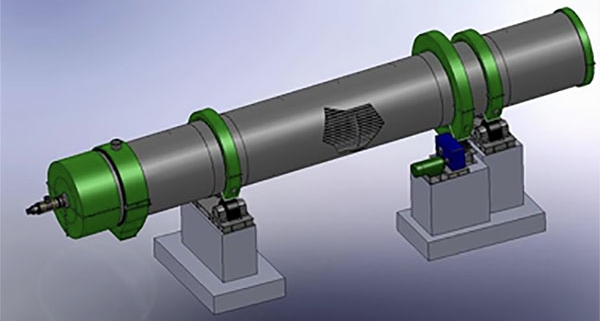Project project
At present, the drying of conventional water-containing powder materials mostly uses an existing drum dryer. This kind of equipment not only consumes a lot of energy, but also has a large floor space, and excessive exhaust emissions are likely to cause dust to pollute the environment. For the drying of paste materials, drying equipment such as a drum dryer, a rotary flash dryer, and a hollow blade dryer are currently used. The drum dryer and the rotary flash dryer are easy to cause dust to pollute the environment due to the use of hot air drying, high energy consumption and large exhaust gas displacement. The hollow blade dryer is a conduction heating dryer, which has low energy consumption and a small amount of exhaust gas treatment, but is limited by its structure and operation mechanism, and the treatment amount is small. For the drying of liquid materials, spray dryers are currently used; however, due to the excessive energy consumption of spray dryers, the operating costs are high, especially in environmental protection industries.
In order to solve the above problems, the company is currently working on the hot shaft mixing drying process and related equipment research.
Project achievement
1. Successfully developed the hot shaft mixing drying process and equipment, and thoroughly mixed and dried with the pre-laying dry material in the dry layer to greatly improve the heat exchange area, improve the drying efficiency, and improve the heat of the wet material. Mass transfer, thereby increasing the material drying rate; and avoiding the occurrence of wrap-around of the added wet material, thereby greatly reducing the power of the drying shaft device;
2. The hot shaft mixing and drying device comprises a bottom of a plurality of superimposed drying unit layers and a drying bin, and each drying unit layer structure is composed of two cloths arranged in a rectangular casing and a hollow blade forming a pair of fan blades. The shaft and the feeding system are composed, and the feeding system is arranged above the two parallel hollow blade shafts;
3. The feeding system comprises: a spiral feeding system for drying the aqueous powdery material and the paste material, the two parallel hollow blade shafts and the upper spiral feeding system constitute a drying unit layer of the spiral feeding system; or the sports car for the liquid material drying The system, two parallel hollow vane shafts and the upper sports car feeding system constitute a drying unit layer of the sports car feeding system;
4. The spiral feeding system drying unit layer is composed of two hollow vane shafts and a spiral feeding mechanism. One pair of fan-shaped vanes on the two axially parallel hollow vane shafts cross each other, and the spiral feeding mechanism above the two hollow vane shafts is composed of The spiral cloth device and the feeding port of the wet material are composed, the feeding port of the wet material is located above one end of the spiral cloth device; the outer end of the hollow blade shaft is connected with the stirring motor through the transmission mechanism, and the inner hole of the hollow blade shaft is connected with the steam source; The cloth device is composed of one end of the cloth spiral shaft and the cloth motor, and the cloth spiral shaft is located at a center position above the two hollow blade shafts;
5. The drying unit layer of the sports car feeding system consists of two hollow blade shafts in a rectangular casing and a reciprocating sports car feeding device. One pair of fan blades on the two axially parallel hollow blade axes cross each other, and two hollow blade shafts The top of the vehicle is provided with a sports car feeding device; the sports car feeding device is composed of a feeding sports car, a sports car chute and a feeding pipe, and a feeding nozzle is arranged on the feeding pipe; a volatilizing steam discharge port is arranged above one side of the rectangular casing; the drying bin is a rectangular parallelepiped structure a discharge port is arranged above the drying bin to communicate with the bottom of the rectangular casing;
6. The whole system adopts a drying device composed of a single or a plurality of drying unit layers superposed to realize mixing of the powdery dry material and the wet material of the drying operation, and drying the wet material by the blade stirring of the hot shaft and the heating of the hot shaft, The steps at work are as follows:
1) There are powdery dry materials in the shell at the beginning of the drying operation and during the normal drying process; 2) The wet material is uniformly added to the drying layer of the hot powdery dry material in the axial direction by the upper fabric mechanism. Medium, in the hot shaft blade agitation, quickly mix with the hot dry material in the housing;
3) The wet material is mixed with the hot dry material to make the high temperature dry material particles coated with a layer of wet material, increase the heat exchange area, accelerate the heat transfer of the wet material, thereby increasing the material drying rate; The state of the material in the body is always in a flowing state, so that the state of the material in the drying device is always in a mixed state, avoiding the work of the material in the high-viscosity water interval in the casing, and avoiding the winding of the wet material;
7. When the wet material is a water-containing powder material and a paste-like material, the cloth mechanism adopts a spiral feeding method, so that the wet material is evenly added on the dry material in the rectangular shell, and the two hollow structures of each drying unit layer structure are rotated. The vane shaft is heated by steam or heat transfer oil to heat and dry the wet material in the shell to evaporate the material. At the same time, the hollow vane shaft stirs and heats the mixed material through the blades thereon to make the material continuously Heat transfer on the heat transfer surface of the blade;
8. When the wet material is liquid material, the cloth mechanism adopts the sports car feeding mode to drive the feeding nozzle through the sports car that reciprocates axially along the rotary axis, and the liquid material conveyed from the conveying pipe is evenly added to the dry material in the rectangular casing. The two hollow vane shafts of each drying unit layer structure are heated by steam or heat transfer oil to heat and dry the materials in the shell to evaporate the material; and the hollow vane shaft is mixed by the vane pairs thereon. The material in the state is stirred and heated to continuously exchange heat with the heat transfer surface of the blade;
9. During drying, as the wet material is continuously added, the dry dry material is discharged from the discharge port, and the volatile gas is discharged from the side exhaust outlet;
The technical solutions developed by this project have the following advantages:
The drying efficiency is greatly improved by thoroughly mixing and drying the pre-packed dry material in the dried layer with the newly added material. That is, the microscopic high-temperature dry material particles are coated with a layer of wet material, which greatly improves the heat exchange area, improves the heat mass transfer of the wet material, thereby improving the material drying rate; macroscopically, the material state in the casing is always in a flowable state. The state of the material in the drying device is always the state of mixing, avoiding the high-viscosity water content of the material, avoiding the situation that the wet material of the equipment is wrapped around the shaft, thereby reducing the power of the shaft of the equipment;
1) Conducive to large-scale production and manufacturing of drying equipment;
2) reduce the required floor space of the drying equipment;
3) Because the mixing drying process is adopted, the material is prevented from being wound around the shaft, thereby greatly reducing the driving power;
4) The mixing drying process improves the heat exchange efficiency of the material and reduces the operating cost;
5) The drying process of the liquid material is greatly shortened, and the auxiliary equipment in the drying process of the traditional liquid material is reduced;
6) The process combination is convenient, not only can a combination of processes such as series and parallel can be performed, and each dry layer can also work alone.



